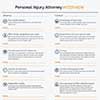Find out whether you might have a defective product or products liability case
Most products are safe and work as intended. But every now and then a manufacturer makes a mistake and a product hits the shelves that was poorly designed, has a defect, or lacks proper warnings or instructions.
If you were injured by a product, you might be able to file a lawsuit to recover damages for your injuries. This type of lawsuit is called a “product liability lawsuit.”
Let’s take a closer look at these types of lawsuits in Arizona.
Types of product liability cases
First, you should know that there are 3 main categories of product liability claims:
- Manufacturing defect claims
- Design defect claims
- Inadequate warning or instruction claims
Understanding these 3 categories will help you determine whether or not you have a valid claim.
Manufacturing defect claims
Most product liability cases are based on manufacturing defects. A defectively manufactured product is one that—though properly designed—left the manufacturer in a condition other than the one intended. In other words, some error occurred during the manufacturing process that caused the product to become unsafe.
A manufacturing defect could be just about anything, but here are some common examples:
- The wrong type of screw, bolt, or fastener was used on a mechanical part
- Two parts were attached incorrectly
- An outdated component was accidently installed
- Electric circuitry was accidently installed backwards
- A critical component became cracked during the manufacturing process
Defective design
A claim based on a defective design takes issue with the way the product was designed. A product is defectively designed if you can show that it failed to perform as safely as a reasonable person would expect, even when the product is used as intended (or at least in a manner that was reasonably foreseeable).
To put it another way, nothing went wrong in the manufacturing process per se, the product is simply inherently dangerous by design. An example of a defective design might be a product designed for children that represents a severe choking hazard.
Failure to warn
Manufacturers have a duty to warn users of the dangers inherent in their products. To use the example above, if a toy represents a choking hazard, the box should contain a warning to parents and perhaps an age restriction.
Do manufacturers have to warn about every conceivable danger? No.
Manufactures are only responsible for warning users about:
- Dangers that occur while the product is used as intended
- Dangers that can be reasonably anticipated
For example, a cough syrup that fails to include a warning that it may cause serious side effects if taken in combination with another commonly taken drug, such as tylenol, might constitute a defect product lawsuit based on failure to warn.
In addition, manufacturers are required to provide adequate operating instructions and warn users of the possible consequences of failing to follow those instructions.
How to establish a product liability claim
A product liability claim can be brought under a theory of negligence or strict liability. Typically, a plaintiff will use the theory of strict liability because it’s easier to prove. Let’s take a quick look at both theories.
Negligence vs. strict liability
In a product liability case based on negligence, the plaintiff must prove that:
- The defendant owed the plaintiff a duty of reasonable care (manufacturers owe a duty of care to all potential users of their products)
- The defendant breached the duty of reasonable care owed to the plaintiff
- The defendant’s breach was the proximate cause of the plaintiff’s injuries
In a product liability case based on strict liability, the plaintiff doesn’t need to prove that the defendant breached any sort of a duty. Rather, the plaintiff only needs to show that:
- A product was sold in an “unreasonably dangerous” condition
- The unreasonably dangerous condition existed at the time the product left the defendant’s control
- The dangerous condition was the proximate cause of the plaintiff’s injuries
Timeline for filing a product liability claim
Arizona's deadline for filing product liability lawsuits is usually 2 years from the date of the injury. Under Arizona's discovery rule, the clock doesn't start ticking until you discover (or, with reasonable diligence, should have discovered) the injury.
Common defective product defenses
The primary defense in a product liability suit is that the real cause of the harm was a substantial modification or misuse of the product.
For example, if you soak your contacts in paint thinner and damage your eyes when you put on your contacts the next morning, the manufacturer of the paint thinner will argue that you misused the paint thinner. The manufacturer will also argue that there was no way they could have foreseen that you would use paint thinner as a contact solution.
To be sure, this example is extreme. Product liability cases become more complicated when the misuse of the product is arguably foreseeable.
For instance, if you use adult shampoo to wash your infant's hair and the shampoo harms your infant, the manufacturer might argue that using adult shampoo on an infant was a misuse of the product. But, a judge or jury might find that even though it wasn’t the intended use, it was nevertheless a reasonably foreseeable use.
Another common defense in Arizona product liability cases is the defense of overconsumption. In Arizona, if an injury was caused by the repeated consumption of a food product that’s not dangerous when consumed in reasonable quantities, the defendant (food manufacturer) cannot be held liable for the injury.
Keep in mind also that Arizona follows the pure comparative fault theory. Under this theory, the amount of damages a plaintiff can recover is reduced by a percentage that reflects their own degree of fault—no matter what that percentage may be.
Product liability damages
Compensation for defective product injuries aren’t capped in Arizona. Whether a product liability case is brought as a negligence or strict liability claim, the following damages are available:
- Economic damages (medical expenses, lost income, etc.)
- Non-economic damages (pain and suffering, emotional distress, etc.)
- Punitive damages (in cases where the defendant’s actions were grossly negligent or intentional)
Punitive damages are NOT available in the following situations in Arizona:
- The product that allegedly caused the harm was designed, manufactured, packaged, labeled, or sold according to the terms of an approval of a government agency.
- The product complied with all Arizona statutes, rules and regulations.
- The lawsuit is based on a contract provision concerning the product and that provision was authorized or permitted by a government agency
As you can see, product liability claims in Arizona are complex. If you think you might have a defective product claim, we encourage you to consult with an attorney who can help you with the legal implications of your injury while you focus on getting better. Use our free online directory to find an experienced Arizona product liability attorney near you.
Be sure to find an attorney who makes you feel comfortable, who puts your needs first and who devotes the necessary time to your case.
Read lots of reviews and ask people who have used product liability attorneys before.

Worksheet with questions to ask a personal injury attorney to help determine if he or she will be a good fit for your case
Download in PDF format
What does an injury lawyer do?
A personal injury lawyer helps individuals who have sustained injuries in accidents to recover financial compensation. These funds are often needed to pay for medical treatment, make up for lost wages and provide compensation for injuries suffered. Sometimes a case that seems simple at first may become more complicated. In these cases, consider hiring an experienced personal injury lawyer. Read more














